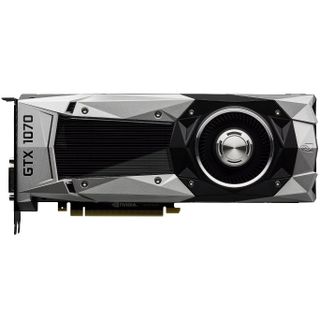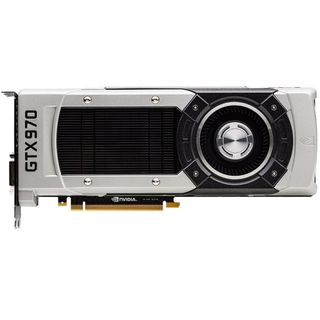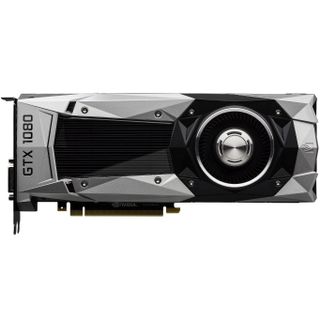Updated: Nvidia GeForce GTX 1070 8GB Pascal Review

Meet The GeForce GTX 1070
Editor's Note: We've updated the article to include power, heat and noise measurements on pages six, seven, eight and nine.
A couple of weeks ago, we introduced the world’s fastest desktop-oriented GPU in our Nvidia GeForce GTX 1080 Pascal Review. Reactions were mixed, not surprisingly—any time you deal with a topic as contentious as graphics, half of the audience walks away impressed, while the other half decries a lack of progress. But there’s no arguing the benchmarks. GeForce GTX 1080 beats GeForce GTX Titan X across the board. It beats Radeon R9 Fury X across the board. And there’s a good chance the 1080 will go uncontested for much of 2016 as AMD prepares its Polaris architecture for a run at the more volume-oriented segment.
Where Nvidia seemed to step in it was the decision to charge an extra $100 for its reference card, now called the Founders Edition. Many Tom’s Hardware readers are reluctant to pay more than MSRP for the industrial design made popular by its radial fan and windowed shroud, particularly since overclocking appears limited by the cooler’s lack of thermal headroom.
Prepare yourself for the same debate, then, as Nvidia lifts the veil on GeForce GTX 1070 performance. The company tells us the Founders Edition card will sell for $449. Meanwhile, board partners are readying their own designs starting at an MSRP of $379. Availability isn’t expected until June 10th though, so it remains to be seen if those prices hold or if launch-day demand drives them up. Such is the trouble with paper launches.
At least we can be confident that the performance of GeForce GTX 1070 won’t change. The card we have in our lab represents what you’ll have access to in a couple of weeks, and it’s an impressive piece of hardware.
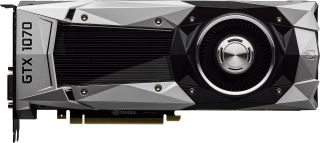
Pascal, In Depth
We go into more detail on Nvidia's Pascal architecture and its features in our Nvidia GeForce GTX 1080 Pascal Review. If you haven't read that story yet, check it out. There's a lot more to GP104 than the specifications indicate!
Stay on the Cutting Edge
Join the experts who read Tom's Hardware for the inside track on enthusiast PC tech news — and have for over 25 years. We'll send breaking news and in-depth reviews of CPUs, GPUs, AI, maker hardware and more straight to your inbox.
Meet The GeForce GTX 1070
You’ll notice that GeForce GTX 1070 looks almost exactly like the 1080. Indeed, it borrows a lot from its big brother, both electrically and mechanically.
There’s the GP104 GPU, to start. Whereas GeForce GTX 1080 comes equipped with a full GP104 sporting 20 Steaming Multiprocessors across four Graphics Processing Clusters, 1070 sheds a complete GPC, losing five SMs in the process. That leaves it with 15 SMs, or 1920 CUDA cores (vs. 2560) and 120 texture units (vs. 160). Nvidia further detunes its Pascal-based processor by dialing the GPU’s base frequency to 1506MHz and its specified GPU Boost clock rate to 1683MHz (these are 1607MHz and 1733MHz, respectively, in the GTX 1080).
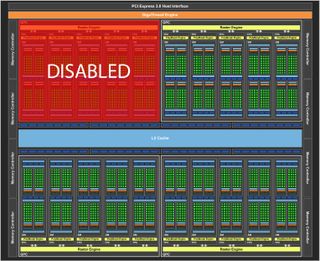
Nvidia doesn’t touch the chip’s back-end. You still get eight 32-bit memory controllers with eight ROPs and 256KB of L2 cache bound to each. In total, that’s 64 ROPs and 2MB of L2. But whereas the GeForce GTX 1080 sports 8GB of 10 Gb/s GDDR5X, 1070 gets 8GB of 8 Gb/s GDDR5 from Samsung. Memory bandwidth consequently peaks at a nice round 256 GB/s, or 14% higher than GeForce GTX 980. The GeForce GTX 980 Ti and Titan X actually benefit from more throughput than the 1070 due to their 384-bit interfaces (as do several AMD cards with 384- and 512-bit buses). However, Nvidia maintains that the improved delta color compression we discussed in our GTX 1080 review yields 20% more effective bandwidth by reducing bytes fetched.
Aside from the model name etched into its shroud, the GeForce GTX 1070 Founders Edition looks just like the 1080, and that’s good. Dating back to the GTX 690, Nvidia’s industrial design influenced what we expect from a high-end graphics card. And although I personally prefer the cleaner lines of generations past to this new faceted body, it’s more important that cooling and acoustics are well-executed. We expect board partners to offer configurations with superior thermal capacity. However, those models typically exhaust waste heat back into your chassis. Some enthusiasts are fine with that and design their PCs accordingly. But as the owner of a small form factor gaming system, I have to be more discerning. Nvidia’s radial fan pushes heated air through aluminum fins and out the I/O bracket.

Under the shroud, differences between the 1070 and 1080 become more apparent. Whereas the 1080 employs a vapor chamber solution, 1070 sports an aluminum heat sink with three embedded copper heat pipes. Almost assuredly this is a cost-cutting measure related to the 1070’s 150W TDP. A lower-power card simply doesn’t need such a beefy cooler, even if it would undoubtedly help GeForce GTX 1070 overcome some of the thermal limits we saw the 1080 hit.
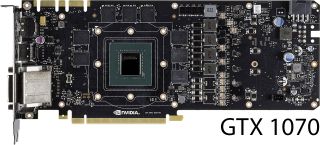
Down at the PCB level, Nvidia implements a four-phase dual-FET design instead of the 1080’s five-phase power supply. Check out the 1070's bare PCB above, and the 1080's below for comparison.
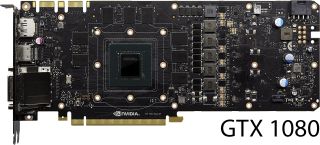
The GTX 1070’s I/O bracket includes the same three full-size DisplayPort 1.3/1.4-ready outputs as 1080, along with one HDMI 2.0b connector and a dual-link DVI port. Up top, you’ll again find two SLI interfaces that accommodate Nvidia’s new high-bandwidth bridges. Nothing changes with regard to SLI support: two GPUs are still the max, although the company will presumably give 1070 owners access to the same unlock key available to anyone with a 1080, enabling three- and four-way setups as well. And GeForce GTX 1070 similarly sports a single eight-pin connector to complement power delivered across the 16-lane PCIe slot.
MORE: Best Graphics Cards
MORE: All Graphics Content
Current page: Meet The GeForce GTX 1070
Next Page How We Tested GeForce GTX 1070-
adamovera Archived comments are found here: http://www.tomshardware.com/forum/id-3073584/nvidia-geforce-gtx-1070-8gb-pascal-performance-review.htmlReply -
nitrium So given the simultaneously lower price and higher performance of the partner boards, only an actual idiot would buy the "Founder's Edition" GTX 1070?Reply -
George Phillips I feel that I should regret getting MSI 1070 FE. MSI's custom designs perform superior then FE cards in every way. Very impressive. Asus and Gigabyte's custom designs must also do better than FE cards.Reply -
Krushe When you're talking about the heat on FE cards. I think the default fan speed is 45-50% at 83c. Make it 80% and the card never reaches 70c even with boost clock up to 1900+. What speeds are the MSI fans running at during your temp measurements?Reply -
DookieDraws Edit: The article has been updated, so I deleted my original comment about the MSI GPU.Reply -
Tony Casagrande "This means that the lowest possible GPU Boost clock rate step gets eliminated from the bottom of the BIOS’ table. So, if you want an additional space at the top, you need to make room for it by getting rid of the very bottom one."Reply
If it were me, I would have removed a low to middle clock rate instead of the very lowest to get both the low idle power consumption and the OC speed. -
neblogai Regarding the possible audible noise because of power spikes on PEG: it is not really about cheap MB, but about using analog audio out of MB, and not anything digital, right?Reply
Also, about overclocking: I think reviews of all these new generation nVidia and AMD cards should include average clock that cards operated when doing all game benchmarks. Official boost clock numbers are a bit useless, because AMD cards run games at below boost clocks, and average for nVidia GTX1070 is above boost clocks. Having just official boost clock numbers make it difficult to evaluate overclocking potential and make real gains look much bigger or smaller than expected. -
Calculatron Am I the only one that noticed that the Founder's Edition cards managed to pull over 75 watts from the motherboard PCIe slot and that no one went bonkers over it?Reply
Most Popular


